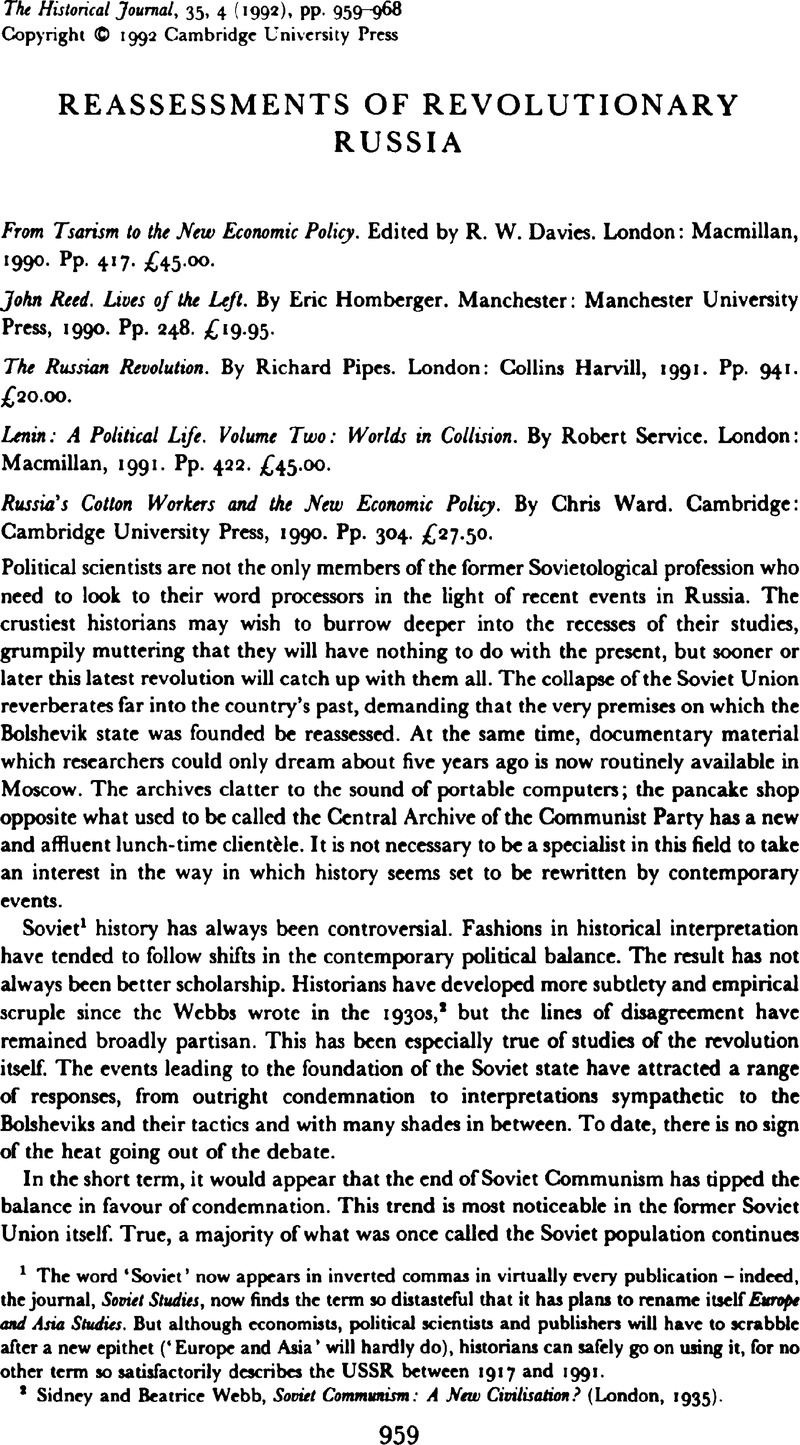Article contents
Reassessments of revolutionary Russia
Published online by Cambridge University Press: 25 March 2010
Abstract

- Type
- Review Articles
- Information
- Copyright
- Copyright © Cambridge University Press 1992
References
1 The word ‘Soviet’ now appears in inverted commas in virtually every publication – indeed, the journal, Soviet Studies, now finds the term so distasteful that it has plans to rename itself Europe and Alia Studies. But although economists, political scientists and publishers will have to scrabble after a new epithet (‘Europe and Asia’ will hardly do), historians can safely go on using it, for no other term so satisfactorily describes the USSR between 1917 and 1991.
2 , Sidney and Webb, Beatrice, Soviet Communism: A New Civilisation? (London, 1935)Google Scholar.
3 Surveys of public opinion in the former USSR have become big business since 1987. The most reputable are conducted by the Institute for the Study of Public Opinion in Moscow.
4 The first major salvo was fired in the pages of Novyi Mir (1990, no. 4) by Tsipko, Alexandr, at the time a member of the Party's central committee staff. Subsequent commentators have not always agreed with his analysis. Otto Latsis, for example, examined some of his main contentions (Kommunist, 1991, no. 1) and accused him of misquoting Lenin in order to build a case against himGoogle Scholar.
5 The extent of the disarray is amply revealed in the debate between the so-called ‘revisionists’ and their opponents in Russian Review, 1986, vol. 45.
6 Pipes, p. xxi.
7 The list is growing every year, but among the most influential are the following: Koenker, Diane, Moscow workers and the 1917 revolution (Princeton, 1981)Google Scholar ; Mandel, David, The Petrograd workers and the fall of the Old Regime (London, 1983)CrossRefGoogle Scholar ; Mandel, David, The Petrograd workers and the Soviet seizure of power (London, 1984)Google Scholar ; Raleigh, Donald J., Revolution OH the Volga, 1917 in Saratov (Cornell, 1986)Google Scholar ; Smith, S. A., Red Petrograd; revolution in the factories, 1917-1918 (Cambridge, 1983)CrossRefGoogle Scholar.
8 Pipes, p. xxiv.
9 Pipes, p. xxiii.
10 For an example, sec pp. 512-13, where in the space of three paragraphs Pipes cites Pctronius' Satyrion, the Cossack and Turkic origins of the Russian word for looting, and the lessons to be drawn from the Pugachev rebellion of the 1770s.
11 Pipes' treatment of Fritz Fischer's work on Germany's war aims in 1914 is a case in point (pp. 195-6). In fact, Germany's war aims, and even more, Russia's, are the subject of intense debate (for a recent discussion, see Strachan, H., ‘The First World War: causes and course’, Historical Journal, XXIX, 1 (1986), 227–55), but Pipes' account skates over it all. The only reference in this section is to Fischer's books of 1961 and 1975CrossRefGoogle Scholar.
12 Pipes, p. 690.
13 Pipes, p. 166.
14 Pipes, p. 170.
15 The remark was made by Alexeev, a fellow-soldier (cited in Pipes, p. 441).
16 Boris Savinkov described Kornilov thus in 1917, but Pipes' account is entirely sympathetic to the remark (p. 442).
17 Pipes, pp. 123-8.
18 Pipes, p. 132. The inspiration for this excursion into intellectual history is Augustin Cochin, the French historian who described the work of societes de pensee as primarily destructive. As he put it, ‘Thought…does not gain in freedom, orderliness, clarity except to the extent that it sheds its real content, its hold on that which exists.
19 Pipes, p. 130.
20 Pipes, pp. 135-59.
21 Pipes, p. 131.
21 See, for example, Pipes, p. 135, for a description of Bakunin's position.
22 Professor Pipes is not only a distinguished academic, but for several years served on the US National Security Council as Director of East European and Soviet Affairs.
23 Pipes, pp. 347-8.
24 Pipes, p. 190.
25 Service, R., Lenin: a political life. Volume me, the strengths of contradiction (London, 1985), introduction, p. viiiCrossRefGoogle Scholar.
26 Service, Worlds in Collision, pp. 113–18Google Scholar.
27 Service, pp. 155–60Google Scholar.
28 Service, pp. 216–22Google Scholar.
29 Service, p. 313.
30 Service, p. 129.
31 Ibid.
32 Service, p. 153.
33 Such as when he engaged a tram conductress in a political discussion while en route, in strictest secrecy, to the Smolnyi Institute on the eve of the insurrection. Service, p. 261.
34 His original plan for returning to Russia in 1917 had involved his disguise as a ‘blind, deaf and dumb Swede’. Krupskaya, a woman seldom noted for the vigour of her wit, scotched the idea by pointing out that he might give the game away by talking about politics in his sleep. Service, p. 150.
35 As Service points out, it was very foolhardy to be photographed wearing his disguise of a full wig and worker's cap.
36 Service, pp. 258-9.
37 Service, p. 273.
38 It is available in hardback only, price £19-95.
39 Karl Kautsky is a good candidate for any list, for example, as is John Maclean, but we must wonder why A. J. Cook, John Strachey, or Ramsay Macdonald should come before, say, Rosa Luxemburg or Sylvia Pankhurst.
40 Davies, p. 21.
41 Laue, T. H. von, Why Lenin? Why Stalin? A reappraisal of the Russian revolution, 1900-1930 (London, 1966)Google Scholar ; Geyer, Deitrich, Russian imperialism: the interaction of domestic and foreign policy (London, 1987)Google Scholar ; Lieven, D. C. B., Russia and the origins of the First World War (London, 1983)CrossRefGoogle Scholar.
42 Davies, p. 26.
43 Davies, p. 18.
44 Merl, Stephan, ‘Socio-economic differentiation of the peasantry’, p. 60, inGoogle ScholarDavies, , From tsarismGoogle Scholar.
45 Ward himself makes extensive use of the work of Lazonick, W. H.. See Journal of Eemomic History, XLV, 1 (Mar. 1981), and 3 (09. 1981)Google Scholar.
46 See Ward, chapter 3, ‘Field and factory’.
47 Ward, p. 59.
- 1
- Cited by


